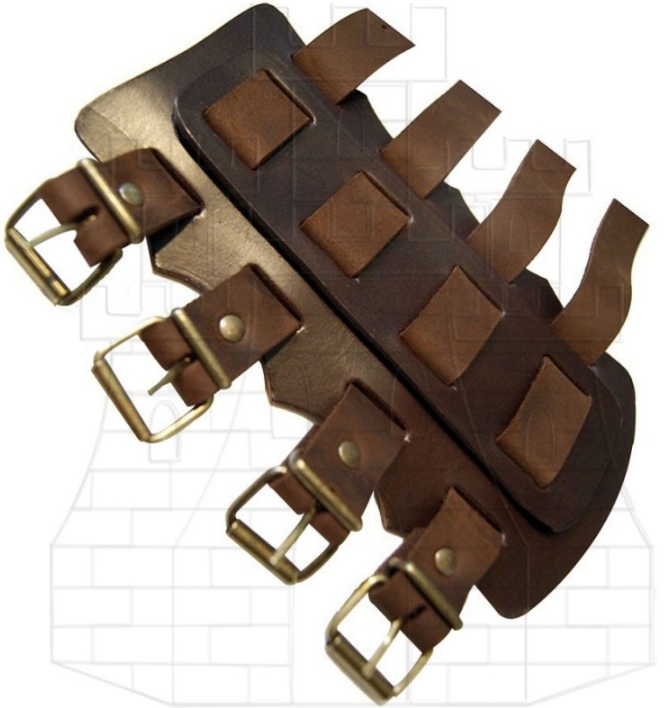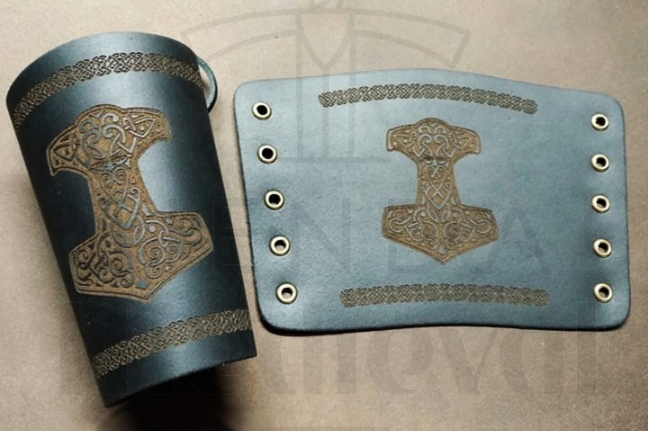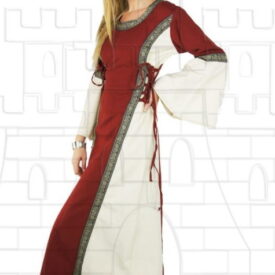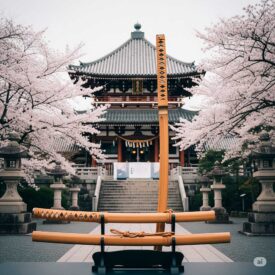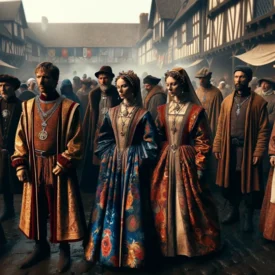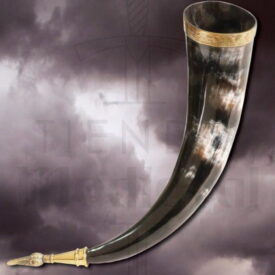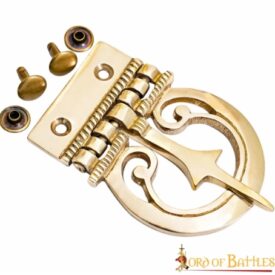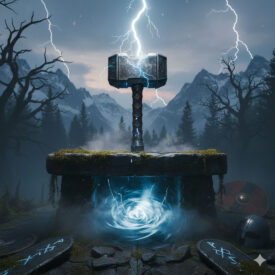Viking bracelets are much more than simple ornaments; they are a window into a rich culture and a fascinating era. These pieces of jewelry, which transcend time, are powerful symbols of status, courage and belonging that connect the past with the present in a unique way. Diving into their history is to discover the soul of an indomitable people whose legacies still resonate today.
A Journey to the Heart of the Viking Age: Its Historical and Social Meaning
The Viking Age, which spanned roughly from 793 to 1066 AD, was a period of great expansion and transformation for the Nordic peoples. Originating in Scandinavia—today encompassing Norway, Sweden and Finland—the Vikings became known for their adventurous spirit and, often, for their bold raids. A landmark that marked their entry into history was the attack on the Lindisfarne Monastery in England in 793, an event that symbolized the beginning of an era of exploration, trade and, at times, fierce raiding.
In this society, the use of ornaments and jewelry carried great importance. Beyond mere aesthetics, these pieces were an unmistakable sign of distinction, reflecting the social position and wealth of the wearer. Brooches, fibulae and garment pins were common adornments, but earrings, necklaces and, of course, the iconic bracelets—mainly made of silver and bronze—were also worn with pride.
Bracelets, together with rings, were particularly reserved for tribal chiefs and the most prominent warriors. They were not only a sign of prosperity and high social rank, but also served a practical function as a form of portable currency. In a society where minted coinage was not always the norm, bracelets could be cut into smaller pieces, known as “hack-silver” or “hack-gold,” to be used in trade exchanges. This versatility made them a valuable asset both in local trade and in the extensive trading networks the Vikings established across Europe and beyond.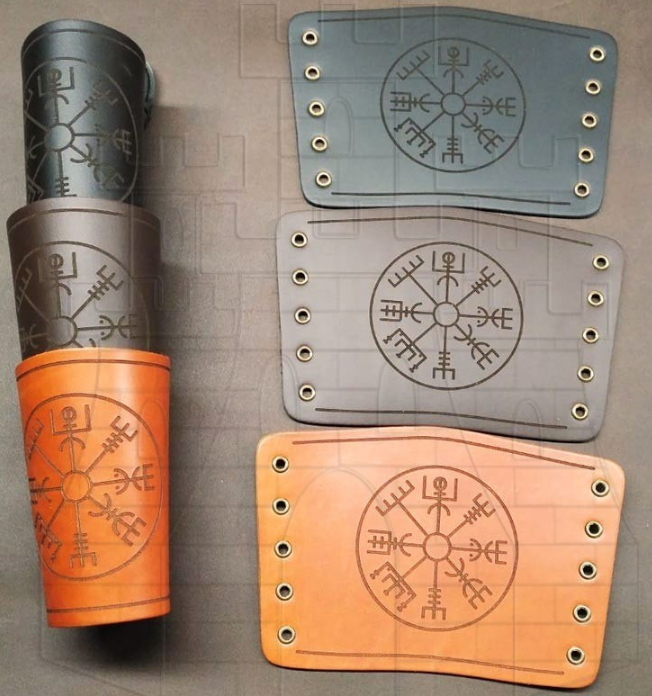
Moreover, a bracelet could be an award of immense symbolic value. It was common for a leader or jarl to gift a bracelet to his most valiant warriors as a reward for their loyalty and bravery in battle. This act not only recognized individual merit but also strengthened bonds of loyalty and the warrior’s commitment to his leader. Thus, the bracelet became a tangible testament to deeds and a constant reminder of honor and group belonging.
Beyond their material and social value, Viking bracelets symbolized strength, courage and cohesion within the community. They often bore intricate engravings with runes or mystical patterns believed to offer protection and good fortune to their wearer. In essence, they were personal amulets that connected the individual with the power of the gods and fate.
Materials and the Art of Viking Goldsmithing: An Ancient Mastery
The making of Viking bracelets is a testament to the exceptional craft skill of the Norse, renowned for their advanced metallurgical techniques. Viking goldsmithing stood out especially for jewelry made in gold filigree, a delicate technique that involved working with very fine metal threads. Occasionally, these pieces incorporated foreign coins—both Arabic and Anglo-Saxon—that reached Scandinavia thanks to the Vikings’ extensive trade networks, adding an exotic touch and extra value to the pieces.
The materials used in crafting these bracelets reflected both the individual’s wealth and the Vikings’ trade connections with other cultures:
- Precious and Common Metals: Bronze was a common and accessible material, widely used due to its availability and ease of working. However, silver and gold were reserved for the wealthier and the elite of Viking society. Silver, often associated with the moon and magical powers, was highly valued. Gold, for its part, represented the sun and divine power and was the most prestigious metal.
- Other Materials: Leather was also widely used, prized for its durability, strength and the ease with which it could be carved or repoussé-worked. Other elements such as amber (known as the “gold of the north”), colored glass and various semi-precious stones, like rock crystal or carnelian, were incorporated into designs, often with the belief that they possessed special or magical properties.
The manufacturing techniques used by Viking silversmiths were varied and sophisticated:
- Filigree: As mentioned, this technique involved using very fine metal threads, usually gold or silver, which were twisted and soldered to create intricate and delicate patterns.
- Casting: Molten metal was poured into clay or stone molds to create specific shapes, from simple bracelets to pieces with animal or geometric motifs in relief.
- Repoussé: This technique consisted of hammering or pressing the metal from the reverse side to create a raised design on the surface.
- Granulation: Small metal spheres were soldered onto the surface of the jewel to create textures and detailed patterns.
- Engraving: Sharp tools were used to incise designs and runes directly onto the surface of metal or leather.
The detail in the engravings and patterns was a distinctive hallmark of Viking art. Produced jewelry could be unique pieces destined for tribal chiefs and elite warriors, but mass-produced items were also made for more common use among the population, demonstrating the democratization of certain adornments within Viking society.
Designs and Symbols: Hidden Messages in Metal and Leather
A principal element of Viking art is intertwined zoomorphic figures that create complex low reliefs and engravings. These motifs were used across a wide range of products, from shields and ship rudders to commemorative stones and, of course, bracelets, where they maximized the technique and decorative ability of the era’s craftsmen. Viking bracelet designs were as varied as they were rich in symbolism.
These patterns not only beautified the jewel but were also believed to protect the wearer or grant special powers—a common trait in medieval historical jewelry. Each symbol told a story, invoked a deity or promised a blessing:
- Knots and Braids: These intricate patterns, which have no beginning or end, represent infinity, eternity and the interconnection of all things in the Norse cosmos. They symbolize the continuity of life and fate.
- Animal Motifs: Dragons and serpents are recurring symbols of strength, protection and, sometimes, primordial chaos. The Fenrir wolf, a mythological creature of immense power, or the Midgard Serpent (Jörmungandr), which encircles the world, were popular motifs often depicted intertwined, with a deep mythological meaning related to fate and the cycle of life and death. Other animals such as ravens (associated with Odin), bears (strength) and boars (fertility) also appeared.
- Runes: The ancient Viking written characters, known as Futhark, were often incised on leather or metal bracelets. Beyond their function as an alphabet, runes were attributed magical and protective functions. They could contain personal messages, luck formulas, invocations to the gods or even protective spells for the wearer.
- Thor’s Hammer (Mjölnir): One of the most iconic and central symbols of the Viking Age. Thor’s hammer represented strength, protection against evil, fertility and consecration. Those who wore it sought the guardianship of this powerful god, protector of humanity and order. It was a very popular amulet, especially among men.
- The Valknut: Consisting of three interlocked triangles, it is directly associated with Odin, the chief god of the Norse pantheon—god of wisdom, war, poetry and death. It is believed to symbolize Odin’s power over life and death, acting as a protective amulet for warriors fallen in battle, guiding their souls to Valhalla.
- Yggdrasil: The World Tree, a giant ash that connects the nine worlds of Norse cosmology. It symbolizes the interconnection of all things, life, death and rebirth, as well as the order of the universe. Wearing Yggdrasil was a way to connect with the totality of the cosmos.
The choice of symbols could even reflect gender differences; for example, Thor’s hammer was preferred by men, while certain amulets or representations of goddesses were more associated with women, though there were no strict rules and many symbols were universal.
Viking Bracelets Today: Tradition and Style in the Modern World
Fascination with Viking culture has endured through the centuries, and with it the appeal of its distinctive bracelets. Today, Viking bracelets have transcended their historical meaning to become a popular accessory in various contemporary communities. They are both a bold fashion statement and a symbol of strength, connection to tradition and expression of a unique identity.
- Cosplay and Historical Reenactment: For enthusiasts of cosplay and historical reenactment, Viking bracelets are essential pieces that add an unmatched level of authenticity to costumes and portrayals of historical characters. The search for high-quality replicas that accurately emulate original designs and materials is fundamental to achieving maximum realism at events, festivals or audiovisual productions.
- Fashion Trend and Personal Style: In contemporary fashion, Viking bracelets have established themselves as striking, characterful pieces. Their rugged style, intricate designs and rich history make them unique accessories that can be paired with a wide range of outfits—from casual, urban looks to those with a more elegant or alternative touch. They attract individuals seeking to stand out, express their individuality and carry a piece of history and symbolism with them.
- Spiritual and Cultural Connection: For many, wearing a Viking bracelet is a way to honor their roots, connect with Norse heritage or simply express an affinity with the values of courage, strength and exploration represented by the Vikings. These bracelets can serve as personal reminders of resilience and determination in everyday life.
Care and Durability: Preserving Your Viking Jewel
To ensure your Viking bracelet retains its beauty, authenticity and durability over time, proper care is essential. Historical materials, although robust, require attention to preserve their original state or natural patina.
- Regular Cleaning: For metal bracelets (bronze, silver, gold), use warm water and a mild soap (without harsh chemicals). Gently rub with a soft cloth or a soft-bristled brush. It is crucial to avoid abrasive cleaners or strong chemicals, as they can damage the metal, alter its color or remove the desired patina. For leather bracelets, clean them with a slightly damp cloth and dry immediately.
- Proper Storage: Store your bracelet in a dry, cool, dark place, away from direct sunlight and excessive humidity. Moisture can accelerate the oxidation of metals and the deterioration of leather. A jewelry box lined with soft fabric or an individual cloth pouch are ideal to prevent scratches and protect the piece from dust and exposure to air. If you have several bracelets, avoid them rubbing against each other.
- Polishing and Specific Maintenance:
- For Metals: Silver and bronze bracelets can be polished occasionally with a jewelry-specific soft cloth to maintain their shine. However, if your bracelet has an artificial patina (a controlled aging to give it a more authentic look), avoid excessive polishing, as you could remove this desired finish. If the patina is natural and you appreciate it, a light and less frequent polish is sufficient.
- For Leather: Leather bracelets require different care. It is recommended to use products specifically designed for leather care, such as conditioners or balms, to keep the material flexible, hydrated and to protect it from drying out and cracking. Apply them sparingly and rub gently so the leather can absorb them. Avoid soaking the leather and always air-dry it if it becomes wet.
- Avoid Exposure to Chemicals: Remove your bracelet before swimming (especially in chlorinated pools), showering, using household cleaning products, perfumes, lotions or hairsprays. These chemicals can corrode metals, stain leather or damage finishes.
How to Choose Your Viking Bracelet: Tips for Authentic Replicas
When buying a Viking bracelet, whether for its aesthetic, historical or symbolic value, it is key to pay attention to its quality and historical fidelity. Seeking replicas that reflect traditional craftsmanship and materials will ensure a durable and meaningful piece.
- Genuine Materials: Authentic replicas are usually made from materials that emulate the historical ones. Look for bracelets in bronze, sterling silver (925) or, for higher-value pieces, gold. If you opt for leather, make sure it is genuine leather and of good quality, as this will ensure durability and a natural, attractive aging.
- Craftsmanship and Details: Pay attention to the workmanship and details of the bracelet. A quality bracelet should reflect traditional Viking techniques, such as detailed engravings, well-defined interlaced patterns or a handcrafted finish that shows the dedication in its creation. Avoid pieces with coarse finishes or simplified designs that do not capture the essence of Viking art.
- Patina and Finish: Some genuine replicas have an artificial patina to simulate aging and give a more authentic, “worn” look. This patina can enhance design details and add character to the piece. However, there are also polished, shiny bracelets, so choose the finish that appeals to you most.
- Design and Meaningful Symbols: Consider which symbols attract you most and what they mean to you. Are you looking for the protection of Thor’s hammer, the wisdom of the Valknut, the interconnectedness of Yggdrasil or the strength of animal motifs? Research the symbolism behind each design to choose a piece that resonates with your personal values or interests.
- Fit and Comfort: Make sure the bracelet has a size and fit appropriate for your wrist. Some metal bracelets are slightly adjustable, but it is important that they are not too tight or too loose to avoid discomfort or loss. For leather bracelets, check the closure and adjustment options.
- Seller Reputation: Buy from specialized sellers or reputable stores that offer detailed descriptions of materials and the origin of their products. Reviews from other buyers can be a good indicator of quality and authenticity.
If you have a creative spirit and seek an even deeper connection with Viking craftsmanship, you can also consider making your own Viking leather bracelet. There are numerous tutorials and kits that will allow you to craft a unique, personalized piece, adding sentimental value and your own story to the bracelet.
The Perennial Fascination with Viking Bracelets
Viking bracelets are much more than a simple fashion accessory; they are a tangible connection to one of the most enigmatic, powerful and fascinating cultures in history. Each piece embodies cultural richness, profound symbolism and the craft skill of an era of great explorations, conquests and spiritual beliefs. Their timeless beauty and deep meaning continue to capture the imagination of people worldwide, making these bracelets a valuable possession for anyone drawn to the Viking legacy.
From their role as a status symbol and currency in the Viking Age to their role today as a style statement and cultural connection, Viking bracelets are a living testament to a culture that continues to captivate our imagination. Wearing one is wearing a piece of history, a symbol of strength and a reminder of the boldness of those who sailed the seas and forged an indelible legacy.
If you are looking for a piece that combines history, art and deep meaning, we invite you to explore our collection of Viking bracelets and discover the perfect jewel that resonates with your spirit. Also, if your interest extends to other eras, you can see other period bracelets that will complement your style with a historical touch.

